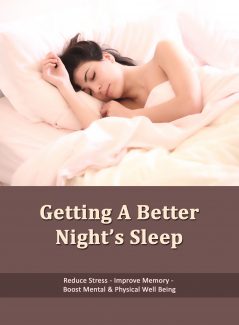
 License Type: Private Label Rights
License Type: Private Label Rights  File Type: ZIP
File Type: ZIP
 SKU: 63163
SKU: 63163  Shipping: Online Download
Shipping: Online Download
Sample Content Preview
Did you know that sleeping at least eight hours a night decreases the risks of obesity, cardiovascular disease, and type II diabetes? Good quality sleep is an essential component of your good health. Sadly, it’s also one of the last things most of us think about when trying to increase productivity.
However, just like eating right, staying hydrated, and exercising moderately, getting a better night’s sleep should be one of the first improvements you make to create a healthy and productive lifestyle for yourself.
A better night’s sleep will also help you reduce stress, improve your memory, and boost your mood – in addition to all the physical health benefits. When you think about it, the idea of losing weight, being healthier, and reducing stress just by sleeping better at night sounds like science fiction. But it’s not. Let’s learn more about how you can get a better night’s sleep so that you can get all these benefits.
How Much Sleep Do We Really Need?
You’ll see a lot of people claim that they don’t need much sleep. However, the truth is most of us need a lot more than we get. There are a few lucky people who, due to their genetics and a rare gene mutation, can function normally on just six hours of sleep each night.
But, six hours is still a good chunk of sleeping for many people today due to the high demands on time. Let’s explore more about how much sleep you really need each night and then learn how to ensure you get it.
Sleep Seven to Nine Hours Each Night
When it comes to getting enough sleep, while it does vary slightly for different people, most of us (as adults) need between seven and nine hours of sleep each night. The only way to be sure that you’re getting enough sleep for yourself is to experiment, but start with the longest period – not the shortest.
Sleep Quality Matters Too
Technically, a person getting enough sleep each night should be able to fall asleep within about 20 minutes without any issues and wake up within 20 minutes when the alarm goes off without much of a struggle. Then, you should be able to get through your day with enough energy to be as productive as you need to be.
About Segmented Sleep
Some people have experimented with the idea of sleeping in two chunks instead of one long night. This idea has come about mostly because many of us have lifestyles that aren’t conducive to sleeping nine hours a night, and history shows that two sleeping shifts were common in some households in the past.
During the most extended sleeping, prehistoric people would visit friends, have sex, pray, and do other calming activities during the sleep break. Not much can be done without sunlight, so nothing too active. Then after a couple of hours, they would go back to sleep until sunrise.
The main thing to understand about that past is that we did not have electricity then, and therefore night-time was longer due to not having artificial lighting. With this standard, they were often really sleeping about ten hours a night, in two approximately five-hour shifts. Additionally, people did not have regular jobs like they do now and instead lived off the land, and their time was used differently.
This method of sleeping can work for people who don’t need or want to live in the daily schedule that exists for most people who have typical day jobs and a normal nightlife. So, if you have an open schedule, it can work for you. Aim for two five-hour shifts, which should result in at least the seven to nine hours of sleep you need each 24 hours.
The main thing to do is to figure out what works best for your lifestyle. More than likely, due to how people live today, it’s easier for you to stick to a regular night-time sleeping schedule and daytime working schedule.
However, don’t force it; if you try something and after a couple months, you’re not experiencing the good health and energy you hoped, try something new. Regardless of when you sleep, getting your sleep environment right is the ultimate way to ensure you can get the quality sleep you need.
Getting Your Sleep Environment Right
No matter what time you plan to sleep, creating an environment conducive to sleep is essential. You really do need to ensure that wherever you sleep is the right temperature, is comfortable to sleep in, and makes you want to sleep. That really does mostly start with your mattress.
Get the Right Bed and Mattress
Choosing the right mattress to sleep on requires that you know your budget, your sleep position, and understand your own physical conditions that may interfere with your ability to sleep.
Know the Type of Mattresses You Like – If you like a bed with some bounce to it, you’ll need to choose an innerspring mattress, while if you like a firm mattress, you’ll want to choose memory foam. If you like something that offers both, you can choose an innerspring mattress with a memory foam topper. Some mattresses are filled with air, like the Sleep Number bed made famous by night-time commercials and the bionic woman; this allows you to control the firmness of the mattress along with your partner.
Know Your Sleeping Style – Believe it or not, the position you like to sleep in matters in terms of the type of mattress and pillows you buy. For example, if you want to sleep on your side, you may need an innerspring over a foam mattress because it may lessen the pressure points you feel on your hips and shoulders. If you sleep on your tummy, you will need a firmer mattress too, because you don’t want to suffocate inside a soft memory foam option.
Sleeping Temperature – If you tend to be a hot sleeper, it’s essential to be mindful of this when choosing a mattress. Many memory foam mattresses have a reputation of warming up quite a bit and causing people who are hot sleepers to be even hotter. If you really want a memory foam but you’re a hot sleeper, find one of the newer “cooling” options.
Dealing with Allergies -- If you have allergies to dust, pets, or the environment, finding a mattress that doesn’t add to it is very helpful. Memory foam is antimicrobial, as well as resistant to dust mites and mold. Innerspring mattresses will need to be covered with an allergy-resistant cover to help avoid the same problems. If you do have sensitivities, you’ll also want to check whether your choice is certified regarding different materials.
Don’t choose something as important as a mattress on the spur of the moment. Give it a lot of thought and go to real stores to try out a mattress before ordering. Try to purchase mattresses that offer a long return option so that you don’t waste your money. A good mattress should last between five and ten years.
Set the Room Temperature Colder
This is one of the more difficult parts to control because it will affect your budget, and it really depends on what type of home you live in. But, the ideal temperature for most people to sleep is about 60 to 67 degrees Fahrenheit.
- License: Private Label Rights
- Category:Ebooks
- Tags:2020 Ebooks Private Label Rights







